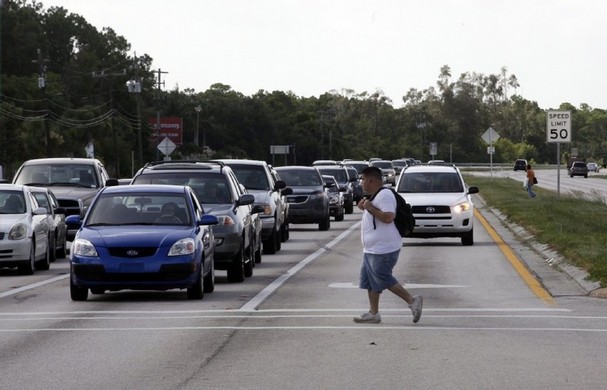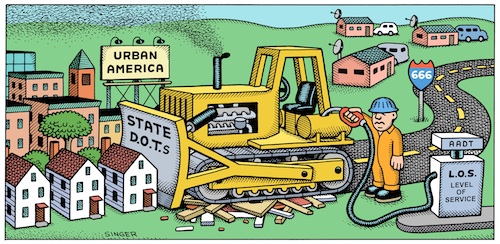There are three little words that will make any livable streets advocate groan: Level of Service.
Level of Service, simply put, is a measure of vehicle congestion at intersections. Projects are graded from "A" to "F" based on how much delay drivers experience.
That's all it measures: the free motion of motor vehicles. And that's the problem. The safety of people on foot and on bikes doesn't enter into the equation at all, and transit vehicles carrying dozens of people are subjugated to the movement of private cars. In fact, a high "level of service" generally makes for a much more stressful and dangerous street, since speeding traffic, and the wide lanes that facilitate it, is a leading cause of traffic injuries and deaths.
Last month, livable streets advocates in California finally made progress in a long battle to reform the state's environmental laws, which perversely rewarded projects that cater to cars and maintain a certain Level of Service. When, for instance, San Francisco went to add a bike lane or a bus lane, the city first had to show -- as part of environmental law -- that drivers would not be inconvenienced. Then on September 27, Governor Jerry Brown signed a law saying that Level of Service requirements would no longer factor into the state's environmental review process -- at least in "transit priority areas," which will incorporate sections of all the state's urbanized areas.
The Natural Resources Defense Council celebrated the bill's passage, writing that it will "have the potential to shape California’s future in a big way."
California isn't the only place rethinking its reliance on Level of Service to grade transportation and development projects. Portland, Oregon, issued an RFP last summer asking for help developing new performance measures to replace Level of Service. The RFP read: "The existing LOS standards and measures, which focus only on motor vehicle levels of service, do not reflect the City of Portland’s current practice which emphasizes and promotes a multi-modal approach to transportation planning and providing transportation services."
Meanwhile, other cities that want to build better streets for walking, biking, and transit are finding ways around Level of Service without changing laws.
Rachel Weinberger helped write Mayor Michael Bloomberg's PlaNYC sustainability framework. Level of Service requirements presented a barrier to safer street designs there, too, but by testing out new engineering approaches as pilot projects, reforms could be advanced without hacking through too much red tape. Internally, the city used performance measures that prioritized goals it considered more important than vehicle Level of Service, such as spatial efficiency.
"A lot of places are trying to rethink it," said Weinberger, who is now director of research and policy strategy at NelsonNygaard. "People are starting to say, 'We’ve been using this performance measure and we’re not getting the whole picture, and we’re not getting the result we really want.'"
The state of Florida, for example, uses a multi-modal Level of Service analysis. The state of Virginia is considering something similar, said Weinberger.
Another innovator is Charlotte, North Carolina. Charlotte first adopted a soft approach to its use of Level of Service about 10 years ago, when the city passed its complete streets policy, says Dan Gallagher, the city's transportation and planning manager.
"We realized if we were going to be a city that could move cars but also be accommodating for bikes, pedestrians and transit users, a strict level of service approach probably wasn’t going to be the best thing," Gallagher said. "What we’ve moved to is more of a comprehensive look at our improvements."
Charlotte still uses Level of Service in its planning, but in combination with metrics that measure "Level of Service" for cyclists and pedestrians as well. Multi-modal Level of Service measures have been pioneered by groups like the National Cooperative Highway Research program.

The city of Seattle is another conscientious objector. Michael James, a project manager at the Seattle Department of Transportation, said the city is considering whether to adopt a multi-modal Level of Service in its next comprehensive plan.
"We’re really trying to move away from using level of service because it really just focuses on driver access and it’s more of a measure of driver convenience than anything else," James said. "We still do use LOS at intersections, but primarily to make sure our transit is still moving."
Of course, for every state or local agency that eschews transportation decisions based primarily on Level of Service, there are many more that use it to quash projects that might be beneficial for pedestrians and cyclists. The sad thing, according to Gary Toth at Project for Public Spaces, is that there is absolutely no requirement for states and cities to do so. Adherence to Level of Service is simply a convention that survives from the bygone era of highway building. Even with the advances in multi-modal Level of Service, many communities will forgo this measure because the data needed to calculate is more difficult to obtain.
"We have a long way to go," says Toth, "but the door is opening."






